Oriole birds are one of the most eye-catching birds you’ll find in your backyard. They are known for their orange and black plumage in the summer season, which contrasts well under the pale green leaves of trees. And, it is always tons of fun attracting all types of orioles to your backyard with oriole bird feeders.
These birds also bring a sweet little tune with their arrival, making them one of the number one species bird watchers look forward to seeing.
There are two classifications of Orioles – The New World and Old World Orioles. But in this article, we’re going to focus only on the New World species, the Icteridae family, because they’re the ones you’ll mostly come across here in America.
In this article, we’ll discuss:
- What orioles are
- The most popular Oriole species you’ll find in North America
- Other New World Orioles you’ll find in South America
- Interesting facts about orioles
So, if you’re curious to know more about these beautiful birds, read on…
What are Orioles?
Orioles are colorful birds that are frequent visitors of backyard bird feeders.
There are many species around the world, and these birds are classified into New World Orioles (Icteridae) and the Old World Orioles (Oriolidae). These two classifications are not related to each other.
Old World Orioles are the birds you’ll find in tropical areas. They are also more related to starlings and feed on fruit and insects. They come in a wide range of colors, from black, orange, to even olive green. They are also more widespread than New World Orioles and are found in Eurasia, Asia, East Indies, Australia, and the Philippines.
There are around 30 species of Old World Orioles, but some of the most well-known are:
- Golden Oriole found in Europe and western Asia
- Olive-backed Oriole found in northern and eastern Australia and New Guinea
- Black Oriole that is endemic only in Malaysia
New World Orioles are the ones you often see in your backyard. They are most known for their orange and black plumage and are generally found only in North America. They are closely related to the blackbird family instead of the starlings.
As I mentioned earlier, in this article, we will focus on the New World Orioles generally found in America.
We’ll take a look at the most popular ones and show how you can easily identify each.
Most Well-known Types of Orioles in North America
There are eight known species of orioles in North America:
- Orchard Oriole
- Audubon’s Oriole
- Altamira Oriole
- Baltimore Oriole
- Hooded Oriole
- Bullock’s Oriole
- Scott’s Oriole
- Spot-breasted Oriole
Belonging to the same family, these birds look very much similar to each other. But below, we’ll learn to differentiate each of them so you can easily tell which Oriole visits your backyard.
Orchard Oriole
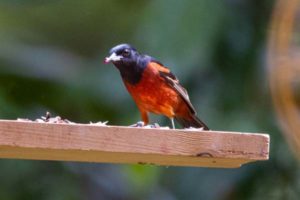
Orchard Oriole Facts
- Common Name: Orchard Oriole
- Scientific Name: Icterus spurious
- Length: 5.9-7.1 inches
- Weight: 0.6-1.0 ounces
- Wingspan: 9.8 inches
Orchard Orioles are slim songbirds with medium-length tails, round heads, and a straight bill.
Male birds are easily identifiable with their black feathers above their heads and back, and reddish-chestnut feathers on their chest and underwings. Female birds, on the other hand, feature a greenish-yellow plumage with two white wing bars and no black color.
These types of orioles are long-distance migratory birds. They mainly breed in the eastern part of the United States and then fly south to Mexico and Southern America for winter.
They are often found in open woodlands near bodies of water, nesting in scattered trees.
Orchard Orioles love insects the most. But will also drink nectar and fruits when insects are not available.
Audubon’s Oriole

Audubon’s Oriole Facts
- Common Name: Audubon’s Oriole
- Scientific Name: Icterus graduacauda
- Length: 7.5 – 9.4 inches
- Weight: 1.1 – 1.9 ounces
- Wingspan: 12.6 inches
Audubon’s Oriole is one of the larger oriole species. They feature a long tail, a large head, and a long, pointed bill with a thick base.
Male and female Audubon’s Oriole have very similar appearances. They feature a bright yellow and black plumage, with their entire head black, entire body yellow, and their entire wings black with white bars. And just like with most birds, male Audubon’s Oriole appear more vibrant than their female counterparts.
These
types of orioles are non-migratory and are only found in South Texas and Mexico.In Texas, you’ll frequently see them in wooded and brushy habitats, while in Mexico, they would become more spread out. They can be seen near bodies of water, cloud forests, deciduous forests, and even in coffee plantations.
They are not frequent visitors of backyard feeders as they can be very shy birds.
Altamira Oriole
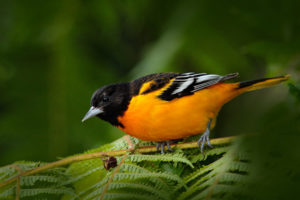
Altamira Oriole Facts
- Common Name: Altamira Oriole
- Scientific Name: Icterus gularis
- Length: 8.3-9.8 inches
- Weight: 1.7-2.3 ounces
- Wingspan: 14.2 inches
Altamira Oriole is one of the larger Oriole’s with a size that is larger than a Brewer’s Blackbird. The bird features a long tail, stock body, a fairly large head, and a long, pointed bill with a thick base.
These birds showcase a bright orange and black plumage. Most parts of their bodies are orange, while they have black areas in front of their eyes, on their chin, on the back, wings, and the tail. They also feature a white wing bar and orange shoulders.
Males are more vibrant than females. And immature Altamira Orioles feature an olive-brown back, a yellow head and body, and no black or white markings throughout their bodies.
These birds are non-migratory and are very rare in the US. You’ll often just see them in Texas and Rio Grande Valley all year round.
Altamira Orioles prefer to stay on open woodlands and visit backyard feeders to feed on sunflower seeds or nectar.
Baltimore Oriole
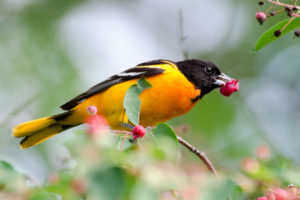
Baltimore Oriole Facts
- Common Name: Baltimore Oriole
- Scientific Name: Icterus galbula
- Length: 6.7-7.5 inches
- Weight: 1.1-1.4 ounces
- Wingspan: 9.1-11.8 inches
Baltimore Oriole is a medium-sized bird with a sturdy body, thick neck, long legs, and a pointed bill with a thick base like many other Orioles.
Male Baltimore Orioles are known for their flame-orange and black plumage. They have a solid black head, their bodies and under tail are of flame-orange color, and their wings are black with white bars.
In contrast to the male birds, female Baltimore Orioles are of lighter plumage. They feature a yellow-orange plumage on their breast areas, and a gray-colored head and back with two white bars on their wings.
These
types of orioles are known to be medium to long-distance migrants, breeding in the eastern parts of the United States while wintering south to Mexico and Southern America. They build their nests in leafy deciduous forests, open woodlands, edges of forests, and near water sources.Baltimore Orioles are also frequent visitors of backyard feeders, and love feeding on insects, fruits, and nectar of flowers.
Hooded Oriole
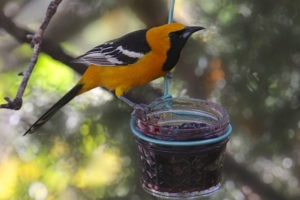
Hooded Oriole Facts
- Common Name: Hooded Oriole
- Scientific Name: Icterus cucullatus
- Length: 7.1-7.9 inches
- Weight: 0.8 ounces
- Wingspan: 9.1-11.0 inches
Hooded Orioles are one of the larger-sized oriole birds. They have long and delicate bodies, long and rounded tails, long necks, and pointed bills slightly curved downward.
Male birds feature a vibrant black and yellow plumage, ranging from bright yellow to flame orange.
The black areas of the birds are mainly their tails, a portion of their back, wings, and the eye portion of their face down to their bib. And as their name implies, their yellow feathers are found on the other parts of the body, starting just above their eye line, making it look like a hood. They also have bold white wing bars.
Female birds, on the other hand, are lighter in color. They feature an olive-yellow overall body, grayish backs, and grayish wings with thin white wing bars.
These
types of orioles are short-distance migratory birds and are found in very few places in southwestern United States and Mexico. They also usually stay in open, dry areas where trees like cottonwoods, sycamores, and palm trees are scattered.They are also regular visitors of backyard feeders and enjoy eating insects, fruit, and nectars the most.
Bullock’s Oriole
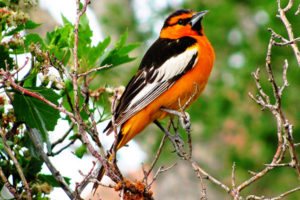
Bullock’s Oriole Facts
- Common Name: Bullock’s Oriole
- Scientific Name: Icterus bullockii
- Length: 6.7-7.5 inches
- Weight: 1.0-1.5 ounces
- Wingspan: 12.2 inches
Bullock’s Orioles are slim medium-sized songbirds. They feature a medium-long tail, small heads, and long, pointed bills with a thick base.
You can clearly differentiate male Bullock’s Oriole because of their bright orange and black plumage. Their back, top of their heads, and tails are all black, face and chest areas are orange, and their wings feature a white patch. You’ll also notice a black line right at their eye area.
In contrast, female birds are of lighter color. They feature yellowish-orange heads and tails and grayish backs.
These
types of orioles are considered medium-distance migrants. They breed in the western part of the United States and move down south to Mexico for winter. You’ll often find them in open woodlands and even urban parks where trees are large and spread out.Like most oriole species, they are also frequent visitors of backyard feeders and love insects, fruit, and nectar.
Scott’s Oriole
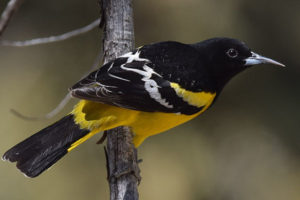
Scott’s Oriole Facts
- Common Name: Scott’s Oriole
- Scientific Name: Icterus parisorum
- Length: 9.1 inches
- Weight: 1.1-1.4 ounces
- Wingspan: 12.6 inches
Photo credit: Andy Reago & Chrissy McClarren, CC BY 2.0, via Wikimedia Commons
Scott’s Orioles are slightly larger than Bullock’s Orioles. They also feature slim and sturdy bodies, strong legs and feet, and long, pointy bills.
Male birds are characterized by a bright lemon yellow and black plumage. Their head, back, tail, and neck areas are black, while their underparts are of lemon yellow color. They also feature some white patches on their wings.
Female birds, on the other hand, have a lighter plumage of dull yellow underparts and olive-green upperparts.
These birds breed in only a few areas in the southwestern United States. They are resident to medium-distance migrants that winter to Mexico or southern California.
You’ll often find them in arid areas like the deserts. And like most Orioles, they love feeding on insects, fruit, and nectar of flowers the most.
Spot-breasted Oriole
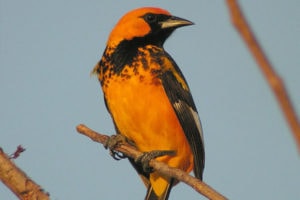
Spot-breasted Oriole Facts
- Common Name: Spot-breasted Oriole
- Scientific Name: Icterus pectoralis
- Length: 8.3-9.4 inches
- Weight: 1.8 ounces
Len Blumin from Mill Valley, California, United States, CC BY 2.0, via Wikimedia Commons
Spot-breasted Orioles are medium-sized birds with the same characteristics as any Orioles above – study bodies, medium-long tails, and pointed bills with thick bases.
The birds feature bright orange and black plumage, where their back area is black, head and underparts are bright oranges, wings are black with white stripes, and there are vivid black spots on their breasts; hence, their name.
These birds are non-migratory and are mainly found in Costa Rica, El Salvador, Guatemala, Honduras, Mexico, and Nicaragua. They love staying in dry forests, moist lowland forests, and even heavily degraded ones.
Other New World Oriole Species
The list above contains the nine oriole species found the most in North America, especially the United States. There are 25 more new world oriole species that you’ll find, especially in South America.
This includes:
- Yellow-backed Oriole (Icterus chrysater)
- Jamaican Oriole (Icterus leucopteryx)
- Orange Oriole (Icterus auratus)
- Yellow Oriole (Icterus nigrogularis)
- Black-backed Oriole (Icterus abeillei)
- Yellow-tailed Oriole (Icterus chrysater)
- White-edged Oriole (Icterus graceannae)
- Campo Troupial (Icterus jamacaii)
- Venezuelan Troupial (Icterus icterus)
- Orange-backed Troupial (Icterus croconotus)
- Bar-winged Oriole (Icterus maculialatus)
- Black-vented Oriole (Icterus wagleri)
- Black-cowled Oriole (Icterus prosthemelas)
- Cuban Oriole (Icterus melanopsis)
- Bahama Oriole (Icterus northropi)
- Martinique Oriole (Icterus bonana)
- Puerto Rican Oriole (Icterus portoricensis)
- Montserrat Oriole (Icterus oberi)
- Saint Lucia Oriole (Icterus laudabilis)
- Hispaniolan Oriole (Icterus dominicensis)
- Orange-crowned Oriole (Icterus auricapillus)
- Variable Oriole (Icterus pyrrhopterus)
- Epaulet Oriole (Icterus cayanensis)
Interesting Facts About Orioles
- There are two types of birds called Orioles – the genus Icterus in North, Central, and South America, and the orioles in the family Oriolidae found in Eurasia, Africa, and Australia.
- Orioles are best known for their bright orange and black plumage.
- Orioles love eating insects, fruits, and nectar.
- Bullock’s Orioles are known to eat only grasshoppers in a day, especially if there’s an abundance of them.
- Baltimore and Bullock’s Oriole play a huge role in pollinating several species of trees.
- Male Baltimore Orioles are known to carry different tunes.
- In the late 1800s, Oriole nests are known to be built solely on horsehair.
- The Baltimore Oriole is the state bird of Maryland.
- They are closely related to meadowlarks, blackbirds, bobolinks, and grackles.
- Altamira Orioles are one of the smartest oriole species you’ll find.
- Baltimore Orioles also earned the name “Vampire of Baltimore” because of their behavior of drinking juices inside fruits and berries by stabbing a hole through them.
- Spot-breasted Orioles are the only orioles wherein male and female birds have the same bright plumage.
- Bahama Orioles are critically endangered Oriole species.
- They are excellent architects, and their nests are masterpieces.
- Baltimore Orioles are named after England’s Baltimore family whose family crest is colored black and orange.
- Bullock’s Orioles were named in honor of William Bullock and his son.
- Orioles can live up to 11 years in the wild, depending on the species.
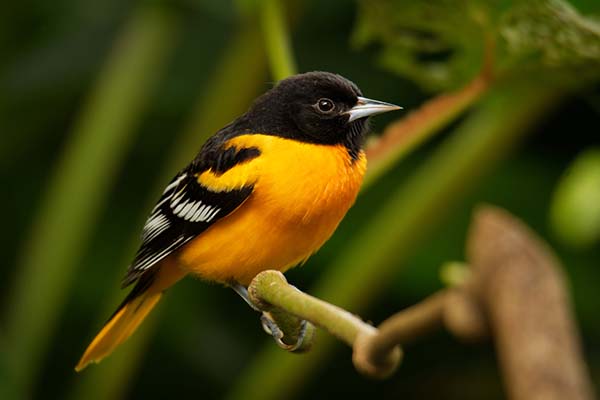
from BirdInformer.com https://ift.tt/3xkziHE

No comments:
Post a Comment